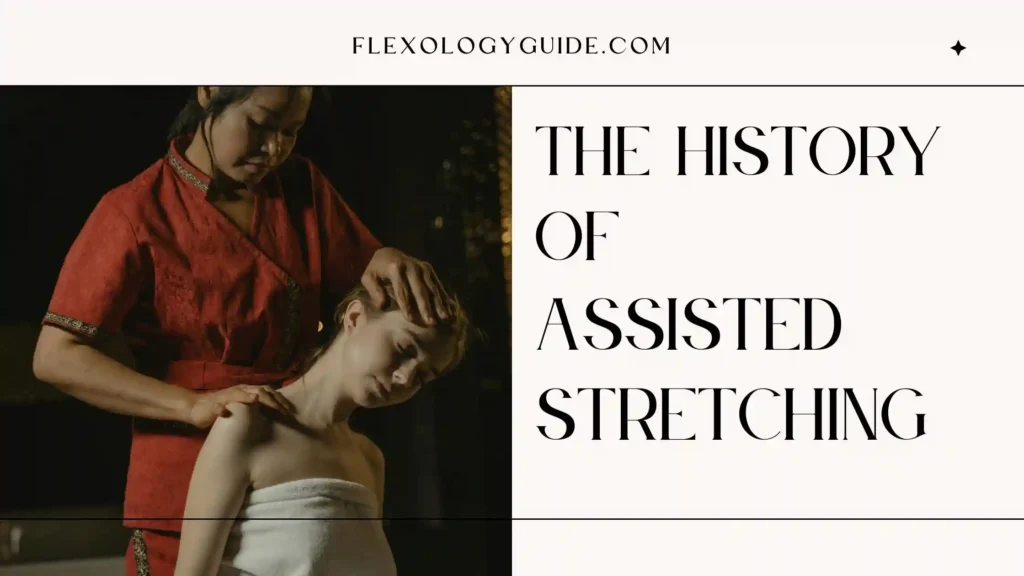The art of assisted stretching has been practiced for centuries. Rooted in ancient healing traditions, it has evolved into a modern approach embraced by therapists, athletes, and wellness enthusiasts. This journey through time explores the origins of assisted stretching, tracing its development from ancient civilizations to today’s cutting-edge techniques.
Ancient Origins (5000 BCE – 1000 CE)
“Flexibility and strength are the foundation of vitality.” – Ancient Yoga Master.
Far to the east, Traditional Chinese Medicine (TCM) embraced assisted stretching as a crucial part of holistic healing. Tuina massage, an ancient therapeutic practice, integrated passive stretching to manipulate the body’s energy pathways, ensuring balance and well-being. Likewise, in Thailand, monks and healers refined Nuad Thai, or Thai Yoga Massage, a system of guided stretching and compression that remains a cornerstone of Thai wellness traditions.
Meanwhile, Greek athletes and Roman warriors relied on assisted flexibility training in the Mediterranean world to maintain their strength and agility. Trainers in Athens’s gymnasia employed stretching techniques to prepare competitors for the Olympic Games, while Roman soldiers used passive stretching drills to enhance combat readiness.
Middle Ages to Early Modern Period (1000 CE – 1800s)
“Healing begins with movement, and movement must be guided with wisdom.” – Avicenna.
During the Islamic Golden Age, scholars like Avicenna recorded extensive medical texts detailing the benefits of manual therapy, including assisted movement techniques to rehabilitate injuries. European physicians followed suit, employing guided stretching to aid recovery and enhance mobility.
In Asia, martial artists recognized the power of flexibility in combat. Japanese Jujutsu practitioners integrated assisted stretching drills to improve their agility and reaction time. Similarly, Chinese Qigong masters used controlled stretches to channel internal energy, refining a practice that continues to thrive today.
In 19th-century Sweden, a physiologist named Per Henrik Ling revolutionized movement therapy by developing structured stretching exercises that blended passive and active assistance. His Swedish Gymnastics system laid the foundation for modern physiotherapy and guided stretching techniques.
Scientific Advancements & Rehabilitation (19th–20th Century)
“To move well is to live well.” – Per Henrik Ling.
As medical knowledge expanded, so did the role of assisted stretching in physical therapy and rehabilitation. By the early 20th century, hospitals and clinics incorporated guided stretching techniques to aid patient recovery. Therapists designed programs to restore mobility, reduce pain, and improve post-injury flexibility.
The mid-1900s marked a turning point in athletic training with the introduction of Proprioceptive Neuromuscular Facilitation (PNF stretching) in the 1940s. This breakthrough technique used controlled resistance and assisted stretching to enhance flexibility and prevent injuries. Sports scientists refined stretching protocols for elite athletes, while massage therapists and chiropractors integrated assisted stretching into their pain management strategies.
Modern Assisted Stretching & Industry Growth (21st Century – Present)
“Technology and tradition must work together to keep the body strong.” – StretchLab Founder.
The 21st century witnessed the rise of dedicated stretching studios and wellness franchises. StretchLab, Stretch Zone, and Stretch U emerged as industry leaders, offering specialized assisted stretching services tailored to diverse populations, from office workers to professional athletes.
Technological advancements further transformed the landscape. AI-driven flexibility assessments and mobile mobility apps now provide personalized stretching programs based on real-time data. Fitness professionals integrate assisted stretching into corporate wellness programs, emphasizing its role in reducing workplace fatigue and improving productivity.
The Future of Assisted Stretching
“The future of the movement is limitless.” – Sports Scientist.
As research on neuromuscular health progresses, the future of assisted stretching holds exciting possibilities. Scientists explore the neural connections between flexibility and longevity while innovators develop robotic-assisted stretching devices to enhance therapy precision. With greater accessibility in healthcare, fitness, and workplace wellness, assisted stretching is poised to become integral to holistic health in the years ahead.
Conclusion
From the ancient yoga halls of India to the high-tech stretching studios of today, assisted stretching has stood the test of time. Its evolution reflects humanity’s ongoing pursuit of movement, balance, and well-being. Whether guided by a skilled therapist or assisted by cutting-edge technology, stretching continues to shape how we move and live.
